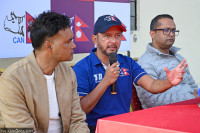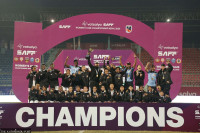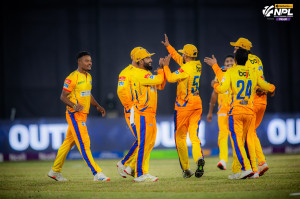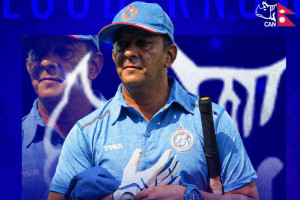Sports
As Games end, Nepal roars with historic medal haul
After 10 days of competitions, the hosts claimed the second spot, after India, on the medal table with 51 golds..jpg&w=900&height=601)
Suman Malla
The curtains came down on the 13th South Asian Games on Tuesday after 10 days of thrilling competition, with Nepal accumulating an unprecedented 51 gold medals to finish second in the medal standings. India once again dominated the final medal count with a total of 312 medals, including 174 golds. Nepal wrapped up the Games with a total of 206 medals.
The Nepali football team ensured that celebrations would continue late into the night after successfully defending their title with a 2-1 victory over Bhutan in the final.
“See you in Islamabad!” read the electronic scoreboard with more than 15,000 spectators cheering as the flag of the South Asia Olympic Council was lowered and handed over to Pakistan—the hosts of the next Games that will be held after two years.
The Games’ flame at the cauldron was extinguished as colourful fireworks lit up the night sky.
Prime Minister KP Sharma Oli thanked all participating athletes, coaches, officials and organisers for their contributions towards making the Games a “grand success”.
“We are proud of ourselves to have rebuilt earthquake-ravaged infrastructure to successfully host the South Asian Games simultaneously in Kathmandu, Pokhara and Janakpur,” Oli said in his address via video conference. “These Games have once again served as a catalyst for unity and friendship among South Asian neighbours through mutual respect and dignity. Sports is indeed the most effective way of uniting people.”
Oli then went on to commend Nepali athletes for their “unparalleled achievement”.
The home athletes’ unprecedented success, indeed, glossed over the organisers’ administrative and logistical ineptitude that was evident both before and during the Games.
Before the Games began, there were concerns over incomplete and shoddy preparations in Kathmandu and Pokhara. The women’s football teams were forced to compete in the stadium in Pokhara without a dressing room. In the Capital, technicians struggled until the last minute to put the heating system, imported from Finland, in working order at Satdobato Swimming Complex.
During the Games itself, an administrative oversight saw the country’s shooting players without proper gear and equipment, forcing them to borrow equipment from competitors.
The organisers’ poor promotion of the Games had even left a majority of citizens aloof about the competitions, said observers.
“Preparations for the Games exposed the country’s soft underbelly,” said Niranjan Rajbanshi, a sports journalist with BBC Nepali Service who has covered every South Asian Games since 1999. “But credit goes to them for braving adverse situations to eventually stage the Games that had been postponed twice.”
However, once the Games began and sports took over, the focus shifted to the vigour and achievements of the athletes, he said.
.jpg)
From a high of 31 gold medals at home 20 years ago to the lows of just three golds in India in 2016, Nepal’s slump at the South Asian Games appears to be definitively over.
This time around Nepal reaped a rich haul of medals in the martial arts events—judo, karate and taekwondo—which saw Nepal better its previous landmark of 31 golds just halfway through the Games. But the more encouraging element of Nepal’s success was the number of medals they won in conventional Olympic events like athletics, boxing and swimming.
And no other star shone brighter than Gaurika Singh.
The 17-year-old swimmer dazzled the Satdobato Swimming Complex, becoming the first Nepali athlete to win four golds at a single Games.
“We are immensely proud of our achievements,” said Ramesh Kumar Silwal, member secretary of the National Sports Council, in his closing speech.
“I was subjected to ridicule when I set our goal for the Games,” said Silwal, recalling when he had predicted that Team Nepal would win 50 gold medals before the Games began. “We’ve not only achieved it, but exceeded it.”
Spurred by the unprecedented success, Silwal, who also chairs the Games’ Executive Committee, declared that this was just the beginning and that preparations would begin immediately for the 14th South Asian Games, as well as for the upcoming Olympics and Asian Games.
Nepal had nearly three years to prepare for these Games, but work only began in earnest three months before the opening.
“We all know we Nepalis are not so well-organised. We often leave everything till the last moment,” said Binod Shankar Palikhe, the former member secretary of the council.
But having gone through the grind himself as organiser of the 8th edition of Games, Palikhe only had praise for Silwal and other officials involved in putting on the Games.
“I can understand how much trouble the member secretary must have been through,” Palikhe said.
Palikhe called on the authorities to accord top priority to the welfare of athletes to take the country’s sports to the next level.
“The government should really give serious thought to the welfare of athletes,” he said. “Instead of announcing small rewards, there should be something like a life policy of Rs4-5 million for athletes.”
Sharat Singh Bhandari, a former sports minister, too said that the sports authorities and government needed to focus more on giving due importance to sports and athletes rather than the pomp and ceremony of the opening and closing events.
As the country has adopted a federal structure, the provincial governments should be handed the responsibility for the development of sports at the grassroots level, he said.
“Sports should be kept free from partisan politics,” said Bhandari, who was at the helm of the Sports Ministry when Nepal last hosted the South Asian Games.
And that’s exactly what the Oli administration is planning to do, according to Deputy Prime Minister and Defence Minister Ishwar Pokhrel.
“The government will shortly come up with a policy,” Pokhrel said in his closing remarks, “so that Nepali athletes won’t have to repent for choosing sports as a career.”




 7.12°C Kathmandu
7.12°C Kathmandu















